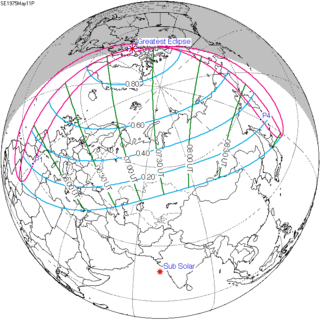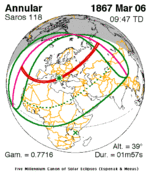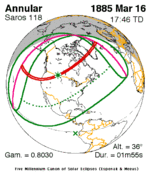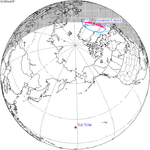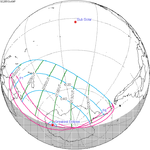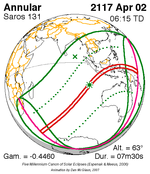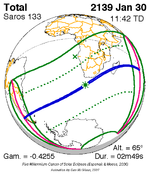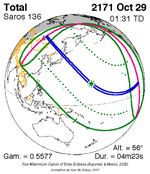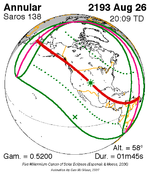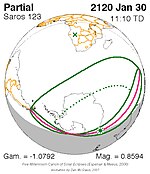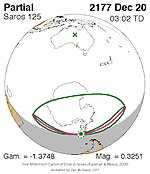
A partial solar eclipse occurred at the Moon's ascending node of orbit between Saturday, November 13 and Sunday, November 14, 1993, with a magnitude of 0.928. A solar eclipse occurs when the Moon passes between Earth and the Sun, thereby totally or partly obscuring the image of the Sun for a viewer on Earth. A partial solar eclipse occurs in the polar regions of the Earth when the center of the Moon's shadow misses the Earth.
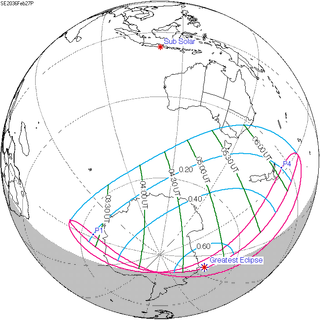
A partial solar eclipse will occur at the Moon's descending node of orbit on Wednesday, February 27, 2036, with a magnitude of 0.6286. A solar eclipse occurs when the Moon passes between Earth and the Sun, thereby totally or partly obscuring the image of the Sun for a viewer on Earth. A partial solar eclipse occurs in the polar regions of the Earth when the center of the Moon's shadow misses the Earth.

A partial solar eclipse occurred at the Moon's ascending node of orbit on Wednesday, April 9, 1986, with a magnitude of 0.8236. A solar eclipse occurs when the Moon passes between Earth and the Sun, thereby totally or partly obscuring the image of the Sun for a viewer on Earth. A partial solar eclipse occurs in the polar regions of the Earth when the center of the Moon's shadow misses the Earth.
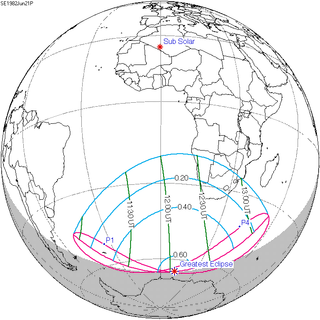
A partial solar eclipse occurred at the Moon's ascending node of orbit on Monday, June 21, 1982, with a magnitude of 0.6168. A solar eclipse occurs when the Moon passes between Earth and the Sun, thereby totally or partly obscuring the image of the Sun for a viewer on Earth. A partial solar eclipse occurs in the polar regions of the Earth when the center of the Moon's shadow misses the Earth.
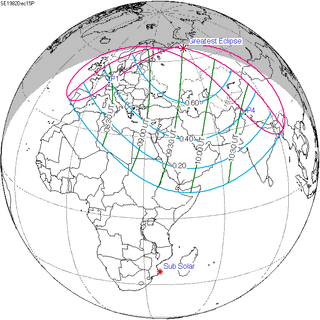
A partial solar eclipse occurred at the Moon's descending node of orbit on Wednesday, December 15, 1982, with a magnitude of 0.735. A solar eclipse occurs when the Moon passes between Earth and the Sun, thereby totally or partly obscuring the image of the Sun for a viewer on Earth. A partial solar eclipse occurs in the polar regions of the Earth when the center of the Moon's shadow misses the Earth.
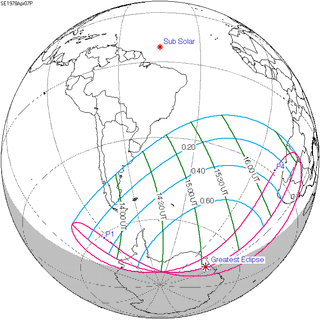
A partial solar eclipse occurred at the Moon's descending node of orbit on Friday, April 7, 1978, with a magnitude of 0.7883. A solar eclipse occurs when the Moon passes between Earth and the Sun, thereby totally or partly obscuring the image of the Sun for a viewer on Earth. A partial solar eclipse occurs in the polar regions of the Earth when the center of the Moon's shadow misses the Earth.

A partial solar eclipse occurred at the Moon's ascending node of orbit on Monday, November 3, 1975, with a magnitude of 0.9588. A solar eclipse occurs when the Moon passes between Earth and the Sun, thereby totally or partly obscuring the image of the Sun for a viewer on Earth. A partial solar eclipse occurs in the polar regions of the Earth when the center of the Moon's shadow misses the Earth.
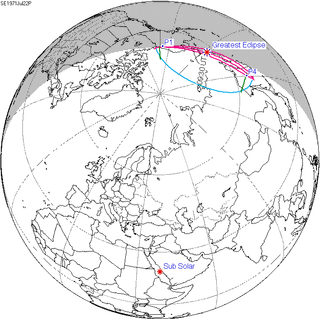
A partial solar eclipse occurred at the Moon's descending node of orbit on Thursday, July 22, 1971, with a magnitude of 0.0689. A solar eclipse occurs when the Moon passes between Earth and the Sun, thereby totally or partly obscuring the image of the Sun for a viewer on Earth. A partial solar eclipse occurs in the polar regions of the Earth when the center of the Moon's shadow misses the Earth.

A partial solar eclipse occurred at the Moon's ascending node of orbit between Thursday, March 28 and Friday, March 29, 1968, with a magnitude of 0.899. A solar eclipse occurs when the Moon passes between Earth and the Sun, thereby totally or partly obscuring the image of the Sun for a viewer on Earth. A partial solar eclipse occurs in the polar regions of the Earth when the center of the Moon's shadow misses the Earth.
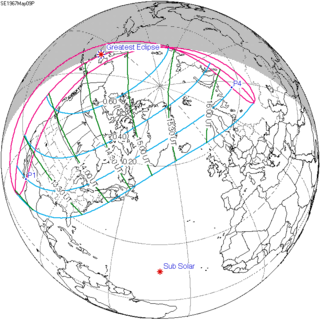
A partial solar eclipse occurred at the Moon's ascending node of orbit on Tuesday, May 9, 1967, with a magnitude of 0.7201. A solar eclipse occurs when the Moon passes between Earth and the Sun, thereby totally or partly obscuring the image of the Sun for a viewer on Earth. A partial solar eclipse occurs in the polar regions of the Earth when the center of the Moon's shadow misses the Earth.
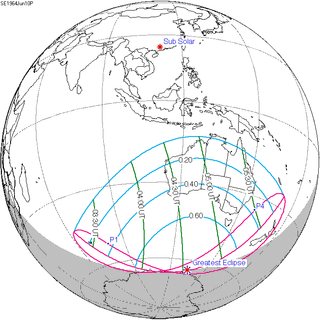
A partial solar eclipse occurred at the Moon's ascending node of orbit on Wednesday, June 10, 1964, with a magnitude of 0.7545. A solar eclipse occurs when the Moon passes between Earth and the Sun, thereby totally or partly obscuring the image of the Sun for a viewer on Earth. A partial solar eclipse occurs in the polar regions of the Earth when the center of the Moon's shadow misses the Earth.
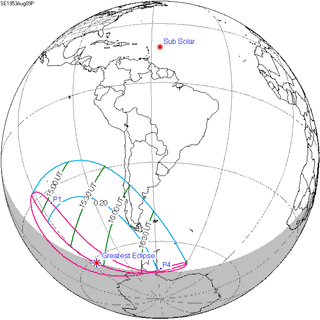
A partial solar eclipse occurred at the Moon's descending node of orbit on Sunday, August 9, 1953, with a magnitude of 0.3729. A solar eclipse occurs when the Moon passes between Earth and the Sun, thereby totally or partly obscuring the image of the Sun for a viewer on Earth. A partial solar eclipse occurs in the polar regions of the Earth when the center of the Moon's shadow misses the Earth.
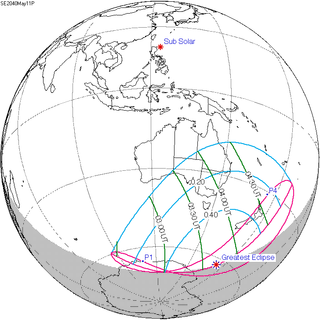
A partial solar eclipse will occur at the Moon's ascending node of orbit on Friday, May 11, 2040, with a magnitude of 0.5306. A solar eclipse occurs when the Moon passes between Earth and the Sun, thereby totally or partly obscuring the image of the Sun for a viewer on Earth. A partial solar eclipse occurs in the polar regions of the Earth when the center of the Moon's shadow misses the Earth.
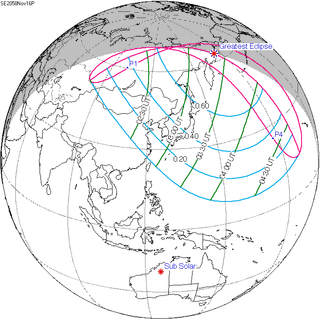
A partial solar eclipse will occur at the Moon's descending node of orbit on Saturday, November 16, 2058, with a magnitude of 0.7644. A solar eclipse occurs when the Moon passes between Earth and the Sun, thereby totally or partly obscuring the image of the Sun for a viewer on Earth. A partial solar eclipse occurs in the polar regions of the Earth when the center of the Moon's shadow misses the Earth.
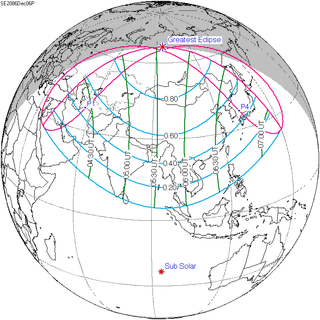
A partial solar eclipse will occur at the Moon's ascending node of orbit on Friday, December 6, 2086, with a magnitude of 0.9271. A solar eclipse occurs when the Moon passes between Earth and the Sun, thereby totally or partly obscuring the image of the Sun for a viewer on Earth. A partial solar eclipse occurs in the polar regions of the Earth when the center of the Moon's shadow misses the Earth.
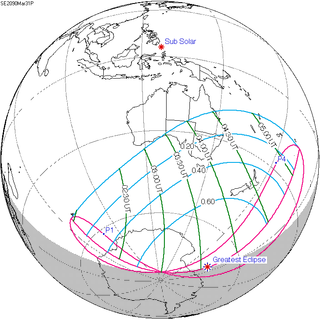
A partial solar eclipse will occur at the Moon's descending node of orbit on Friday, March 31, 2090, with a magnitude of 0.7843. A solar eclipse occurs when the Moon passes between Earth and the Sun, thereby totally or partly obscuring the image of the Sun for a viewer on Earth. A partial solar eclipse occurs in the polar regions of the Earth when the center of the Moon's shadow misses the Earth.
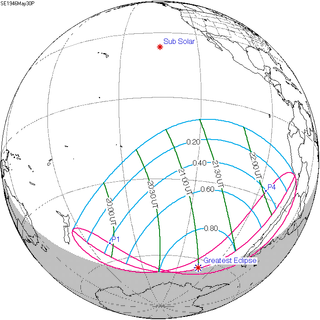
A partial solar eclipse occurred at the Moon's ascending node of orbit on Thursday, May 30, 1946, with a magnitude of 0.8865. A solar eclipse occurs when the Moon passes between Earth and the Sun, thereby totally or partly obscuring the image of the Sun for a viewer on Earth. A partial solar eclipse occurs in the polar regions of the Earth when the center of the Moon's shadow misses the Earth.
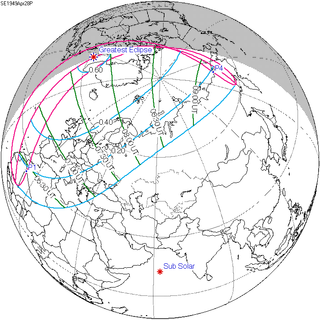
A partial solar eclipse occurred at the Moon's ascending node of orbit on Thursday, April 28, 1949, with a magnitude of 0.6092. A solar eclipse occurs when the Moon passes between Earth and the Sun, thereby totally or partly obscuring the image of the Sun for a viewer on Earth. A partial solar eclipse occurs in the polar regions of the Earth when the center of the Moon's shadow misses the Earth.

A partial solar eclipse occurred at the Moon's ascending node of orbit on Thursday, September 10, 1942, with a magnitude of 0.523. A solar eclipse occurs when the Moon passes between Earth and the Sun, thereby totally or partly obscuring the image of the Sun for a viewer on Earth. A partial solar eclipse occurs in the polar regions of the Earth when the center of the Moon's shadow misses the Earth.

A partial solar eclipse occurred at the Moon's descending node of orbit on Saturday, December 24, 1927, with a magnitude of 0.549. A solar eclipse occurs when the Moon passes between Earth and the Sun, thereby totally or partly obscuring the image of the Sun for a viewer on Earth. A partial solar eclipse occurs in the polar regions of the Earth when the center of the Moon's shadow misses the Earth.
